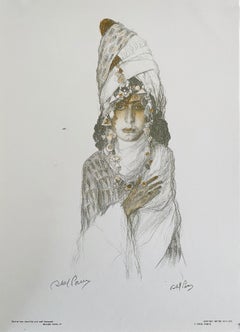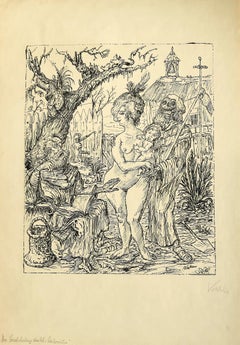Eugène Carrière Art
to
1
1
1
1
Dealer: Barbara Leibowits Graphics
Le Fondeur Paris [Steel Worker]
By Eugène Carrière
Located in New York, NY
Carriere, Eugene. Le Fondeur, Paris 1900 [Steel Worker], Color lithograph.
Ref: Das Fruhe Plakat 134. 51 x 34 3/4 inches.
Eugène Anatole Ca...
Category
Early 1900s Symbolist Eugène Carrière Art
Materials
Lithograph
Related Items
Abel Pann Israeli Bezalel School Lithograph Judaica Biblical Print Jewish Art
By Abel Pann
Located in Surfside, FL
Abel Pann (1883–1963) was a European Jewish painter who settled in the Talpiot neighborhood of Jerusalem in the early twentieth century and taught at the Bezalel Academy of Art under Boris Schatz.
Abba Pfeffermann (later Abel Pann), born in Latvia or in Kreskowka, Vitebsk, Belarus, was a European Russian Jewish art...
Category
Mid-20th Century Symbolist Eugène Carrière Art
Materials
Lithograph
Die Versuchung des Heiligen Antonius - Original Lithograph by A. Kubin - 1922
By Alfred Kubin
Located in Roma, IT
Die Versuchung des Heiligen Antonius is an original lithograph on simili japanese paper, realized by Alfred Kubin in 1922, Hand-signed, edition of 100 copies.
Ref.: Arnason & Wheel...
Category
1920s Symbolist Eugène Carrière Art
Materials
Lithograph
H 19.69 in W 13.78 in D 0.08 in
Abel Pann Israeli Bezalel School Lithograph Judaica Biblical Print Jewish Art
By Abel Pann
Located in Surfside, FL
Abel Pann (1883–1963) was a European Jewish painter who settled in the Talpiot neighborhood of Jerusalem in the early twentieth century and taught at the Bezalel Academy of Art under...
Category
Mid-20th Century Symbolist Eugène Carrière Art
Materials
Lithograph
Abel Pann Israeli Bezalel School Lithograph Judaica Biblical Print Jewish Art
By Abel Pann
Located in Surfside, FL
Abel Pann (1883–1963) was a European Jewish painter who settled in the Talpiot neighborhood of Jerusalem in the early twentieth century and taught at the Bezalel Academy of Art under...
Category
Mid-20th Century Symbolist Eugène Carrière Art
Materials
Lithograph
Abel Pann Israeli Bezalel School Lithograph Judaica Biblical Print Jewish Art
By Abel Pann
Located in Surfside, FL
Abel Pann (1883–1963) was a European Jewish painter who settled in the Talpiot neighborhood of Jerusalem in the early twentieth century and taught at the Bezalel Academy of Art under...
Category
Mid-20th Century Symbolist Eugène Carrière Art
Materials
Lithograph
Das Grausen - Lithograph After A. Kubin - 1903
By After Alfred Kubin
Located in Roma, IT
Das Grausen is a lithograph realized after a work by Alfred Kubin in 1903, Hand-signed and titled, plate from Faksimiledrucke nach Kunstblättern, edition H. Von Weber.
Included a...
Category
Early 1900s Symbolist Eugène Carrière Art
Materials
Lithograph
H 16.54 in W 13.78 in D 0.08 in
Abel Pann Israeli Bezalel School Lithograph Judaica Biblical Print Jewish Art
By Abel Pann
Located in Surfside, FL
Abel Pann (1883–1963) was a European Jewish painter who settled in the Talpiot neighborhood of Jerusalem in the early twentieth century and taught at the Bezalel Academy of Art under...
Category
Mid-20th Century Symbolist Eugène Carrière Art
Materials
Lithograph
Fruhling - Original Woodcut After Arnold Bocklin - 1890s
By Arnold Bocklin (After)
Located in Roma, IT
Frühling is a wonderful black and white photogravure of the original painting by Arnold Böcklin (Basel 1827 - Fiesole 1901), probably edited by Bruckman...
Category
1890s Symbolist Eugène Carrière Art
Materials
Lithograph
H 18.12 in W 26.38 in D 0.08 in
Illustration from the Series "Les Fleurs du Mal" after Odilon Redon - 1923
By Odilon Redon
Located in Roma, IT
Illustration from the series "Les Fleurs du Mal" is an etching print realized after Odilon Redon and published by Henri Felury in 1923.
Monogrammed on the plate.
Good conditions.
...
Category
1920s Symbolist Eugène Carrière Art
Materials
Lithograph
H 17.72 in W 12.6 in D 0.04 in
Abel Pann Israeli Bezalel School Lithograph Judaica Biblical Print Jewish Art
By Abel Pann
Located in Surfside, FL
Abel Pann (1883–1963) was a European Jewish painter who settled in the Talpiot neighborhood of Jerusalem in the early twentieth century and taught at the Bezalel Academy of Art under Boris Schatz.
Abba Pfeffermann (later Abel Pann), born in Latvia or in Kreskowka, Vitebsk, Belarus, was a European Russian Jewish artist who immigrated to Ottoman Palestine and settled in Jerusalem. He was married to Esther Nussbaum. Pann's youngest son was killed in the 1947–1949 Palestine war. After that loss, he turned to painting scenes of the Holocaust. He died in Jerusalem in 1963.
Pann studied the fundamentals of drawing for three months with the painter Yehuda Pen of Vitebsk, who also taught Marc Chagall. In his youth, he traveled in Russia and Poland, earning a living mainly as an apprentice in sign workshops. In 1898 he went south to Odessa, where he was accepted into the Academy of Fine Arts. In 1903, he was in Kishinev, where he documented the Kishinev pogrom with drawings; an effort that is thought to have contributed to his self-definition as an artist who chronicles Jewish history. Still in 1903, he moved to Paris, where he rented rooms in La Ruche, a Parisian building (which still exists) where Modigliani, Chagall, Chaim Soutine and other Jewish artists also lived. Pann studied at the French Academy under William-Adolphe Bouguereau. He earned his living primarily by drawing pictures for the popular illustrated newspapers of the era. In 1912, Boris Schatz, founder and director of the Bezalel Academy of Arts and Design visited Pann in Paris and invited him to come work in Jerusalem.
In 1913, after traveling in Southern Europe and Egypt, Pann arrived in Jerusalem, where he had decided to settle for life. Pann went to see Schatz and it was decided that he would head the painting department at the Bezalel Academy for several months while Schatz embarked on an extensive overseas fund-raising trip. According to Haaretz art critic Smadar Sheffi, a work form this period with the simple title "Jerusalem" shows a cluster of buildings at sunset "with a sky in blazing orange." The painting is "more expressive and abstract that is typical of his work," and Sheffi speculates that "the encounter with the city" of Jerusalem was a "strong emotional experience" for the artist. Pann returned to Europe to arrange his affairs before moving permanently to the British Mandate of Palestine, but was caught on the continent by World War I. Pann's wartime paintings would prove to be among "the most important" of his career. He made many posters to support the French war effort. He also made a series of fifty drawings showing the extreme suffering of Jewish communities caught in the fighting between Germany, Poland and Russia. Art critic Smadar Sheffi regards them as "the most important part of his oeuvre." These "shocking" drawings put modern viewers in mind of depictions of the Holocaust. Pann's drawings were intended as journalistic documentation of the fighting and were successfully exhibited in the United States during the War. According to Pann's autobiography, the Russians, who were allied with the French, refused to allow a wartime exhibition of the drawings in France. According to The New York Times, the drawings were published in Paris during the war, but the government intervened to block their distribution on the grounds that they "reflected damagingly upon an ally" (Russia).
Upon his return to Jerusalem in 1920, Pann took up a teaching position at the Bezalel Academy and wrote that he was about to embark on his life-work, the painting and drawing of scenes from the Hebrew Bible. He returned briefly to Vienna, where he met and married Esther Nussbaum and purchased a lithographic press, which the couple brought home to Jerusalem. Pann began work on a series of lithographs intended to be published in an enormous illustrated Bible, and although that series was never completed, he is widely admired for the series of pastels inspired by Bible stories that he began in the 1940s. The iconography of these works is linked to the 19th century orientalism. He was part of a movement of contemporary Jewish artists interested in Biblical scenes, including Ephraim Moses Lilien...
Category
Mid-20th Century Symbolist Eugène Carrière Art
Materials
Lithograph
Apocalypse de Saint Jean - Lithographs on Chine collé by Odilon Redon - 1899
By Odilon Redon
Located in Roma, IT
Apocalypse de Saint Jean is a complete suite of 13 b/w lithographs (cover + 12 lithographs) on Chine collé , realized by Odilon Redon. All the lithographs are unsigned, as issued.
P...
Category
1890s Symbolist Eugène Carrière Art
Materials
Lithograph
H 24.81 in W 17.52 in D 0.04 in
Abel Pann Israeli Bezalel School Lithograph Judaica Biblical Print Jewish Art
By Abel Pann
Located in Surfside, FL
Abel Pann (1883–1963) was a European Jewish painter who settled in the Talpiot neighborhood of Jerusalem in the early twentieth century and taught at the Bezalel Academy of Art under...
Category
Mid-20th Century Symbolist Eugène Carrière Art
Materials
Lithograph
Eugène Carrière art for sale on 1stDibs.
Find a wide variety of authentic Eugène Carrière art available for sale on 1stDibs. You can also browse by medium to find art by Eugène Carrière in lithograph, crayon, drypoint and more. Much of the original work by this artist or collective was created during the 20th century and is mostly associated with the modern style. Not every interior allows for large Eugène Carrière art, so small editions measuring 4 inches across are available. Customers who are interested in this artist might also find the work of Edvard Munch, Henry de Groux, and Alfred Kubin. Eugène Carrière art prices can differ depending upon medium, time period and other attributes. On 1stDibs, the price for these items starts at $150 and tops out at $3,000, while the average work can sell for $587.
![carriere painter Le Fondeur Paris [Steel Worker]](https://a.1stdibscdn.com/eugene-carriere-prints-works-on-paper-le-fondeur-paris-steel-worker-for-sale/a_2922/1610896410669/Carriere_E_master.jpg?width=240)

